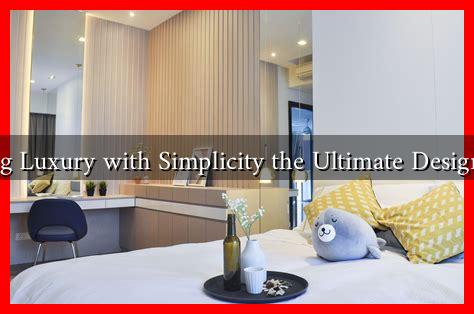-
Table of Contents
Is Mixing Luxury with Simplicity the Ultimate Design Trend?
In recent years, the design world has witnessed a fascinating evolution where luxury and simplicity converge to create a unique aesthetic. This trend, often referred to as “luxury minimalism,” emphasizes the idea that less can indeed be more. As consumers become increasingly discerning, the demand for designs that embody both opulence and understated elegance has surged. But what exactly does this trend entail, and why is it gaining traction? Let’s explore the nuances of mixing luxury with simplicity in design.
The Essence of Luxury Minimalism
Luxury minimalism is characterized by a focus on high-quality materials, craftsmanship, and a clean aesthetic. It strips away the unnecessary while highlighting the beauty of simplicity. This design philosophy is not just about aesthetics; it also reflects a lifestyle choice that values quality over quantity. Here are some key elements that define this trend:
- Quality Materials: Luxury minimalism often incorporates premium materials such as marble, hardwood, and fine textiles that elevate the overall design.
- Functional Design: Every element serves a purpose, ensuring that spaces are not only beautiful but also practical.
- Neutral Color Palettes: Soft, muted colors dominate, creating a serene environment that feels both luxurious and inviting.
- Attention to Detail: Subtle details, such as bespoke furniture or artisanal finishes, add a touch of luxury without overwhelming the senses.
Case Studies: Brands Embracing Luxury and Simplicity
Several brands have successfully adopted this design philosophy, showcasing how luxury and simplicity can coexist harmoniously. Here are a few notable examples:
- Apple: Known for its sleek product designs, Apple embodies luxury minimalism through its clean lines and intuitive interfaces. The brand’s focus on user experience and high-quality materials has set a standard in the tech industry.
- Muji: This Japanese retailer emphasizes simplicity in its product offerings, focusing on functional design and minimalistic aesthetics. Muji’s approach to home goods and stationery reflects a commitment to quality and simplicity.
- Ralph Lauren Home: The luxury brand’s home collection combines classic elegance with a minimalist approach, using rich textures and neutral tones to create sophisticated yet simple living spaces.
The Psychological Appeal of Luxury and Simplicity
The allure of mixing luxury with simplicity goes beyond aesthetics; it taps into deeper psychological needs. In a world filled with chaos and clutter, many individuals seek refuge in serene environments that promote relaxation and mindfulness. Research indicates that:
- Minimalist spaces can reduce stress and anxiety, fostering a sense of calm.
- High-quality, well-designed products can enhance overall satisfaction and well-being.
- Consumers are increasingly valuing experiences over possessions, leading to a preference for thoughtfully designed spaces that reflect their values.
Statistics Supporting the Trend
According to a report by Statista, the global luxury goods market is projected to reach approximately $1.5 trillion by 2025. This growth is driven by a shift in consumer preferences towards sustainable and minimalist designs. Additionally, a survey conducted by Houzz found that 75% of homeowners prefer a clean and uncluttered aesthetic in their living spaces, further underscoring the appeal of luxury minimalism.
Conclusion: The Future of Design
Mixing luxury with simplicity is more than just a fleeting trend; it represents a fundamental shift in how we perceive design. As consumers continue to prioritize quality, functionality, and aesthetics, the demand for luxury minimalism will likely grow. This design philosophy not only enhances our living spaces but also aligns with a broader movement towards mindful consumption and sustainable living. In a world where excess is often the norm, embracing the beauty of simplicity may indeed be the ultimate design trend.

